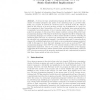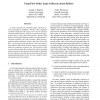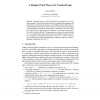92
Voted
JAPLL
2007
15 years 14 days ago
2007
In this paper we introduce Fresh Logic, a natural deduction style first-order logic extended with term-formers and quantifiers derived from the model of names and binding in abst...
127
Voted
FUIN
2007
15 years 15 days ago
2007
We present a resolution calculus for first-order logic using a more concise formalism for representing sets of clauses. The idea is to represent the clause set at hand as a Direct...
98
Voted
FOSSACS
1999
Springer
15 years 4 months ago
1999
Springer
Abstract. A strong (L) logic programming language ([14, 15]) is given by two subclasses of formulas (programs and goals) of the underlying logic L, provided that: firstly, any pro...
100
Voted
WOLLIC
2010
Springer
15 years 5 months ago
2010
Springer
The satisfiability and finite satisfiability problems for the two-variable fragment of first-order logic with counting were shown in [5] to be in NExpTime. This paper presents ...
92
Voted
ICDT
2003
ACM
15 years 5 months ago
2003
ACM
We study extensions of first-order logic over the reals with different types of transitive-closure operators as query languages for constraint databases that can be described by...
106
Voted
CSFW
2003
IEEE
15 years 5 months ago
2003
IEEE
A policy describes the conditions under which an action is permitted or forbidden. We show that a fragment of (multi-sorted) first-order logic can be used to represent and reason...
97
Voted
GG
2004
Springer
15 years 6 months ago
2004
Springer
We show how edge-labelled graphs can be used to represent first-order logic formulae. This gives rise to recursively nested structures, in which each level of nesting corresponds ...
120
Voted
FROCOS
2005
Springer
15 years 6 months ago
2005
Springer
We present one way of combining a logical framework and first-order logic. The logical framework is used as an interface to a first-order theorem prover. Its main purpose is to k...
101
Voted
FOSSACS
2005
Springer
15 years 6 months ago
2005
Springer
Abstract. Nominal logic is a variant of first-order logic equipped with a “freshname quantifier” N and other features useful for reasoning about languages with bound names. I...
131
click to vote
AIIA
2005
Springer
15 years 6 months ago
2005
Springer
Machine Learning systems are often distinguished according to the kind of representation they use, which can be either propositional or first-order logic. The framework working wi...



